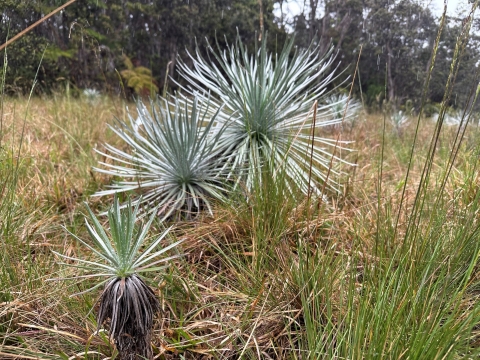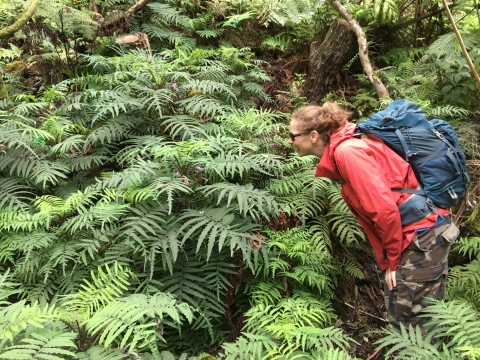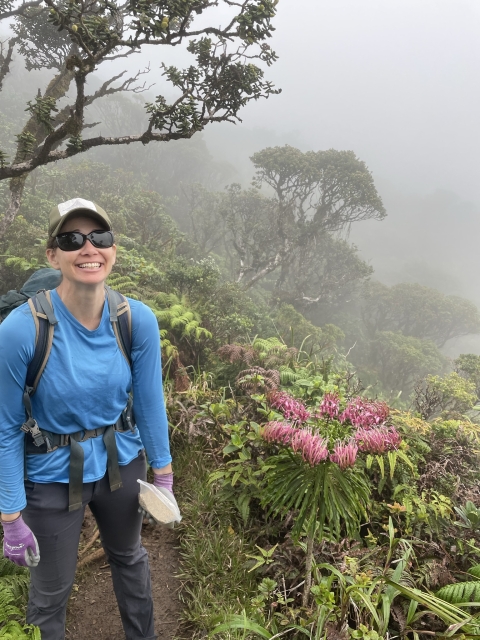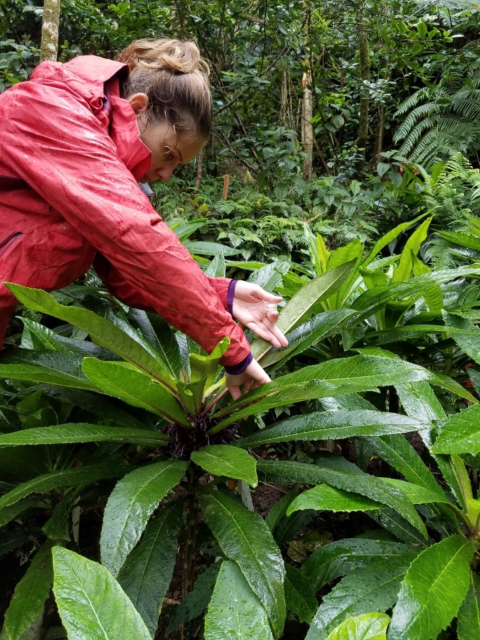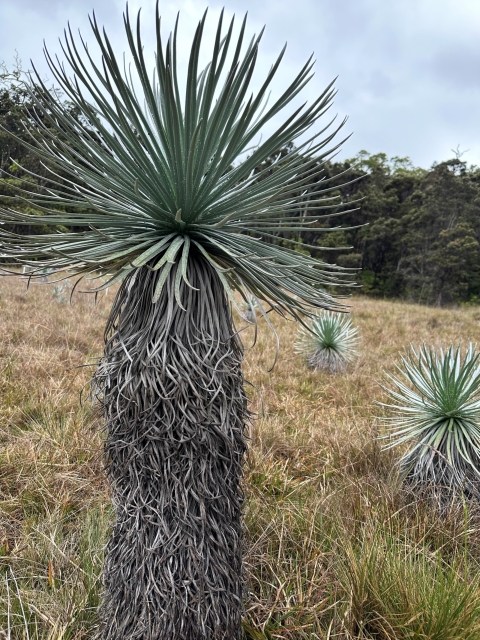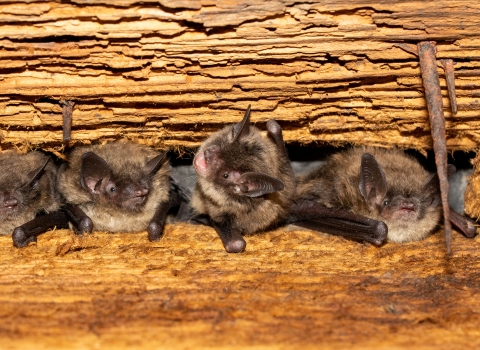This year is the 50th anniversary of the Endangered Species Act, a law that has been a powerful catalyst for conservation of America’s most treasured fish, wildlife, plants and their habitats. In the Pacific Region, our Tribes, state and federal agencies, and partners have joined with our dedicated staff to be the driving force behind the successes we share and the strength ensuring we can address the challenges ahead. Celebrate this milestone with us in this collection of stories as we reflect on past successes, assess current challenges, and envision an equally bright future for the next 50 years and beyond.
Lauren Weisenberger grew up in Bangor, a small rural town in east central Pennsylvania. She went to college for her undergrad in Allentown, Pennsylvania, and gradaute school at the University of Hawaiʻi at Mānoa. Weisenberger has been the plant recovery coordinator with the U.S. Fish and Wildlife Service Pacific Islands Fish and Wildlife Office (PIFWO) for six years. Whether Weisenberger is coordinating Hawaiʻi Rare Plant Genetics Workshops, writing species reports, or making pressed plant bookmarks with keiki for USFWS Bring a Kid to Work Day, her positive attitude and creativity make her so much fun to work with. Daily, she lends her passion to make meaningful contributions for the Service and the communities she engages.
When selecting a species to represent the Pacific Region for the Endangered Species Act 50th anniversary Weisenberger recommended the ʻāhinahina (Kāʻu silversword, Argyroxiphium kauense). This plant species is an excellent example of a recovery success because of the collaboration and teamwork between the Service and partner organizations. With more than 440 federally listed plant species in Hawai‘i, Weisenberger works closely with partners like the Plant Extinction Prevention Program (PEPP) to troubleshoot and find solutions to plant recovery of rare species like the ʻāhinahina. As we celebrate the ESA 50th, it is an opportunity to highlight species and their success stories, but it is equally important to also recognize the people in our agency and those we work with who truly make these recovery efforts possible.
What influenced you into your current career?
My grandfather. My grandparents lived in the Pocono Mountains in Pennsylvania, and I have nice memories of hiking with him through the forest and along the Pocono Creek, observing wildlife, such as white-tailed deer and black bears, and picking blueberries and black walnuts. I used to sit for hours cracking open walnuts in their driveway. My first career-oriented job was at the Lyon Arboretum Seed Conservation Laboratory, where I made the easy transition from eating my harvest to learning how to germinate and store them! I was excited by how much there was to learn about seeds of rare Hawaiian plants, and that every single bit of data we collected at the lab could substantially contribute to the protection and restoration of not only that species, but also closely-related species.
What are you currently working on?
Recovery Plans! With 442 listed plants at PIFWO, we try to invest in a standard approach for providing the best recovery guidance we can for each species. We are currently working on drafting recovery plans for over 100 plant species, and we conduct around 90 plant five-year reviews, annually. Data management is key to the process, and the Recovery and Strategic Habitat Conservation teams at PIFWO are working on how best to collect and organize data to provide us with the data analysis we need to track the recovery of each species.
What is the most rewarding part about the work that you do?
For me, it is making connections between people that help with their efforts in plant conservation and providing any support to species and land managers who are working to prevent species extinctions, restore habitats, and other conservation efforts.
Why are partnerships and collaborations important for the work that you do?
There is so much work to do and it can be overwhelming from time to time. There are so many native plant species in decline, hundreds threatened with extinction daily, and healthy native habitats are becoming exceedingly rare. We need each other to make progress. We also need to hear and share successes and failures, our victories and frustrations, to find the paths forward. We all have unique roles to play in conservation and when those roles intersect and fit together with others, we can make the greatest impact.
This is especially true throughout Hawaiʻi where the flora is such an amazing example of adaptive radiation and speciation. For example, there are dozens of species of Cyanea throughout the islands. So when we learn something about the biology or impacts of threats, for one species, we have information that may be critical for protecting 50 more species.
We have a few examples of how this collaborative process works. The first is the Hawaiʻi Rare Plant Restoration Group, which serves as the International Union for the Conservation of Nature (IUCN) Species Survival Commission, Hawaiian Islands Plant Specialist Group:
“The Hawaiʻi Rare Plant Restoration Group (HRPRG) is an informal alliance of public and private agencies and organizations working to prevent the extinction of native Hawaiian plants and provide for their recovery through integrated in situ (on-site) and ex situ (off-site) efforts through its diverse and committed membership. Partners work collaboratively to sample, propagate, and reintroduce rare plants, and to advance the preservation of native plants and their habitats through effective communication and public education.”
We meet quarterly to hear updates from all partners, as well as updates from subcommittees. The subcommittees focus on the HRPRG best management practices for plant conservation, with guidance ranging from how to collect from rare plants, to growing plants in nurseries, to viewing plants in the wild.
One of the most significant contributions of this network was the effort to recognize and articulate the need for, and creation of, the Plant Extinction Prevention Program (PEPP), whose mission statement is “preserving Hawaiʻi’s rarest plants through teamwork”, and who focuses primarily on species with 50 or fewer wild plants remaining in the wild. Through support through the Service, State of Hawaiʻi, and University of Hawaiʻi, PEPP botanists work on Kauaʻi, Oʻahu, Molokaʻi, Maui Lānaʻi, and Hawaiʻi, and in close collaboration with private landowners and propagation facilities. The PEPP program itself could not exist on its own. The program conducts management at the species level and works across property boundaries and islands to protect these critically endangered plants. It also relies upon propagation and storage facilities to grow plants, store seeds, and conduct research. This model for rare plant conservation has also been adopted in the Mariana Islands.
More recently, several of our partners recognized the need to expand this network to include all aspects of plant conservation in Hawaiʻi, as well as the development of goals to track and report statewide progress across all partners on our shared plant conservation efforts. This effort led to the formation of Laukahi, the Hawaiian Plant Conservation Network, which currently serves as an informal umbrella network for HRPRG and collectively implements the Hawaiʻi Strategy for Plant Conservation.
What does it mean to you to celebrate the ESA 50th anniversary this year?
It makes me excited and grateful to work for the USFWS and to appreciate the significance and utilize the support the ESA gives to protect plants. This is a time to summarize progress and highlight successes and next steps. Argyroxiphium kauense (Kāʻu silversword, ʻāhinahina) is the endangered species representing Region 1 for the 50th anniversary of the ESA. When listed in 1993, there were two populations totaling 540 individuals. Over the following 20 years, the number of individuals declined to fewer than 50 individuals due to persistent threats, such as ungulates. However, the ESA enabled partners to collect seeds and rescue plants from the remnant populations, develop and execute an extensive controlled breeding program to produce thousands of seeds and plants, and reintroduce over 21,000 plants representing 169 founders into protected habitat. These plants have successfully established and reproduced. Careful monitoring over the next decade will provide us with the data to continue to quantify this success and learn from it.
I believe this species of ʻāhinahina emphasizes the value of the ESA, to support partners and landowners to protect and recovery species. When we have the tools to control the threats, we can identify a pathway to recovery. When the tools to control threats are not in our hands, the path forward has temporary roadblocks that we need to work together to remove. Celebrating ESA at 50 is a time to identify and plan for challenges ahead.
Lastly, it is a time to reflect on how we can best protect all species threatened with extinction. Every species deserves protection from extinction, regardless of where they are located or which biological kingdom they belong to. It is the healthy, resilient ecosystem on that land (or air or water) that owns ours and every species, future.
I am incredibly humbled to be a Service employee and serve not only the public but the plants they rely on for survival.
###
The U.S. Fish and Wildlife Service works with others to conserve, protect, and enhance fish, wildlife, plants, and their habitats for the continuing benefit of the American people. For more information, visit www.fws.gov/pacificislands, or connect with us through any of these social media channels at https://www.facebook.com/PacificIslandsFWS, www.flickr.com/photos/usfwspacific/, https://medium.com/usfwspacificislands or www.twitter.com/USFWSPacific.


